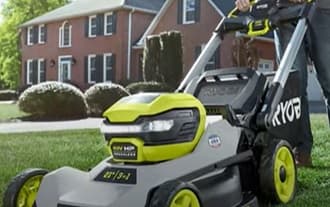As an Amazon Associate, this site earns commissions from qualifying purchases. For more information click here.
Lawn mowers run on two kinds of engine, 2-stroke and 4-stroke. The biggest difference between the two is that 2-stroke engines mix oil and gas, while 4-stroke engines store them separately. But is it possible to run a lawn mower without using oil?
Lawn mowers can start without oil, but this is going to damage the engine. Oil lubricates the pistons, cylinders, crankshaft and other parts for smooth performance. Without oil, these parts will wear out quickly and stop working.
Why Lawn Mowers Need Oil to Run
Whether you own a 4-stroke lawn mower like the Senix or an older 2-stroke model, both require oil. A 2-stroke handles oil differently than a 4-stroke, but neither is going to function without it.
Oil does two things for lawn mowers. First, it serves as an engine lubricant. The cylinders, crankshaft, bearings etc. depend on oil to run smoothly. Second, it keeps engine temperature in the acceptable range.
Engines are made up of many interconnecting parts. When you run a lawn mower, the engine needs to function as smoothly as possible. This is where oil comes in as it lubricates those components.
Take away the oil and engine friction increases. This leads to a higher internal temperature and increases the risk of overheating.
New lawn mowers won’t even start without oil. Older models might, but it’s going to lead to engine deterioration.
The type of oil you use is just as important. Personally I prefer Briggs and Stratton SAE-30 because it provides solid performance and is reliable.
Check your owner’s manual if the manufacturer recommends a specific brand. Most mowers run fine on small engine oil based on my experience. As long as there is 10% or less ethanol and it’s 87 octane, the engine is going to be fine.

What Happens if a Lawn Mower Runs Out of Oil?
Lawn mowers have a low oil indicator so you can refill the tank before it goes empty. But what if you let the lawn mower keep going once oil has run out?
Once oil is gone, the engine is going to stop running. It could take several minutes but at some point the lawn mower will cease working.
Without oil, friction increases among the moving parts. Without any formula to lubricate them, the parts grind against each other. This leads to chipping and wears each part rapidly. This also leads to a temperature increase.
These factors cause severe damage to the cylinders, crankshaft and other parts. They either get stuck together or bits and pieces fall apart. It doesn’t take long for engine damage to set in if you start a mower without oil.
Lawn Mower Started without Oil: How to Fix
It should be obvious by now that you should never use a lawn mower without oil. But what if the oil runs out and you forgot to refill it? Can you still repair the engine?
The longer you leave the engine running without oil, the greater the possible damage. Even a few minutes is enough to cause permanent damage. This is why I never run my lawn mower without oil. Ensuring the engine is in good condition also reduces the risk of lawn mower fires.
If the parts haven’t fused together yet, there’s a chance you can repair the pistons.
Turn the engine off and disconnect the spark plug. Pour some oil spray in the spark plug connector opening. Leave the oil there overnight.
Wear gloves and manually rotate the blade. If all goes well, this will also move the piston. Once it is running again, pump the oil out and use more oil spray.
This fix only applies if the pistons are still running. There are other problems that can come up such as parts welding together, chipping due to friction, low compression, wear and tear, etc.
The best fix of course, is to avoid running lawn mowers without oil. The best way to do this is to make it a habit to check the dipstick before each use.
This video shows how to fix a lawn mower that had oil-related problems.
Does Your Lawn Mower Need Oil Now?
Okay, so lawn mowers need oil. But when should you add oil? Too little or none at all causes problems. But too much oil can cause leaks. Fortunately it’s easy to find out how much oil a lawn mower engine has.
Turn your lawn mower off and look for the dipstick. It is often at either side of the engine, but check the instructions for your model if needed.
The bottom mark on the dipstick indicates there isn’t enough oil. The marker on the top signifies the oil tank is full. With these markers, it’s easy to tell how much is left.
If the oil falls below the required level, add more. Follow the instructions in your manual on how to do so. Keep adding oil until it reaches the top marker.
Do not pour more oil than required. The excess will spill and make a mess. It can make the fuel mixture too rich and cause engine flooding. It’s also a waste.
Push lawn mowers usually require oil change every 50 hours of use. For rider mowers it is after 100 hours. Always replenish to the maximum capacity allowed.
The 50 and 100 hour capacity is for general guidelines only. You might have to change oil more frequently depending on usage.
What is the Best Oil for Lawn Mowers?
Four-stroke lawn mowers are optimized for SAE 30 motor oil. This formula is well suited for small engines running in warm to hot temperature. SAE 30 is ideal for other outdoor tools and small engines.
- SAE 30 is just one type of motor oil. There are other options:
- SAE 10W-30: you can use SAE 10W-30 in different types of weather. But it is best known for starting small engines in mild climates. It runs fine in varying temperature but consumes more than its synthetic variant.
- Synthetic SAE 5W-30: this has the widest temperature operating range. If you’re having trouble starting the engine or using too much oil, SAE 5W-30 is a good option. Check first if your lawn mower supports it.
- SAE 5W-30: this oil works best in cool climates. If you live in a cold area and regular oil doesn’t run well, try SAE 5W-30. Not to be confused with synthetic SAE 5W-30, though that works well in varying temperatures.
- Vanguard 15W-30: think of this as an all-purpose motor oil. I use this on my lawn mower, pressure washer, trimmer and other small engines.
If you’re not sure what to use, check the manual or go to the manufacturer website. Aside from SAE 30, there are other types of oil you’ll come across, but those above are the most common.
Car Oil vs. Small Engine Oil
To be on the safe side, use only oil formulated for lawn mowers. Some lawn mowers will run using automotive oil, but it’s not good for the long term.
To keep things simple:
- If you have a 4-stroke lawn mower, use only oil designed for 4-stroke small engines.
- If you have a 2-stroke model, use only 2-stroke oil.
- Do not use oil unless the product states specifically it is compatible with lawn mowers.
- I also recommend synthetic oils because of better performance, reliability and cost efficiency.
Signs of a Damaged Lawn Mower Engine
The most obvious sign is your lawn mower won’t start. When you turn it on, the engine emits loud noises but doesn’t rev up.
You can also try turning the blade manually. If the blade is stuck the engine has seized. Disconnect the spark plug first before trying this.
There are other signs such as smoke, sputtering, stalling and stopping. The engine might “cough” and refuse to start. Knocking or other weird sounds will come from the engine when you try and start it.
A hotter than normal engine is a possible sign of overheating. Without any lubricating oil, the friction is going to wear out the parts or cause them to weld to each other.

I love the outdoors and all the tools for maintaining gardens, yards and lawns. The only thing I am more passionate about is sharing what I know about garden and outdoor equipment.


